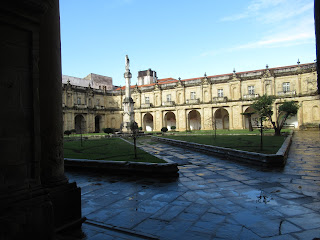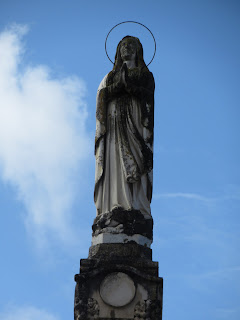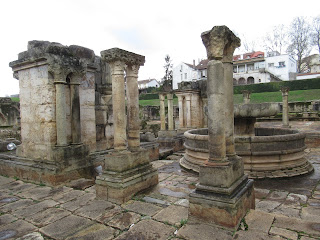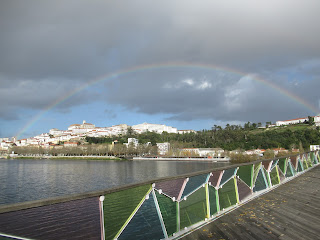About two months ago I returned from being away on vacation with a friend in New Zealand and Australia for 3.5 weeks. In case you also want to follow that really fun trip, here's a link to the newest blog: www.bergersadventures7.blogspot.com
On our last morning in Coimbra we began our day walking across the Santa Clara Bridge which has been a critical link across the Mondego River since Roman times. The bridge was named for Dom Pedro and Dona Ines known as Portugal's Romeo and Juliet.
After the canonization of St. Isabel in 1625, the New Clares Monastery was begun to be built by order of King Joao IV to provide shelter to the Clarissa nuns of the Monastery of Santa Clara-a-Velha or Old Clares Monastery.
We entered the church via the Sacristy which seemed rather odd.
18th century paintings alluded to the life of Queen Isabela also referred to as the Holy Queen and St. Elizabeth.
In Assisi, Italy, young merchant Francesco Bernadone (1181-1226) renounced his possessions and began preaching, humility and fraternity to all of God's creatures after having had a revelation of Christ. Later known as St. Francis of Assisi, his many followers founded the Order of Friars Minor.
The Second Rule, written by Pope Urban IV in 1263, set out strict procedures to reinforce ecclesiastical discipline for all nuns and the Order. It was adopted by most convents including Santa Clara's and the nuns became known as Poor Clares.
Despite being required to wear the modest Franciscan habit tied with a simple rope whose knots symbolized the vows of poverty, obedience chastity, the Poor Clares of Coimbra were given permission to wear "colored habits, shoes, shirts and other tailored or specially made garments" by order of Pope Julius II! Despite living in a Franciscan community, the nuns brought their family status into the convent and inscribed their names on their personal items.
The presence of foods like coconut, beans, sugar, mustard and pepper that were exotic at the time attested to the community's high social status.
Wine: The Iberian habit of drinking a great deal of water was a consequence of the hot climate and spicy food. However, wine was a regular payment as part of the convent's rents. Many containers for liquids were found in the excavations at Santa Clara such as mugs as well as pitchers with interesting motifs.
Hygiene: Though strict rules dictated how often the sisters could wash themselves, high priced imported aromatic products such as musk were used. Exhibits depicted other aspects of personal hygiene such as the cleaning of nails, teeth, ears and eyes.
Ornaments: Despite the restrictions imposed by the Order prohibiting the wearing of jewelry or makeup, lay sisters and nuns took great care of their appearance in the privacy of their quarters as revealed by the various small perfume bottles and ornaments made of wood, rock, amber and bone on display.
Death to the world: Cloistered life represented death to the world, in the sense that every nun should sever her family ties and from material possessions. Nuns were also urged to renounce their possessions at the time of their death and not be "concerned about leaving them to their relatives and friends."
Dying nuns and lay sisters knew they would continue to be part of the community as graves were reserved inside the monastery for them.
Burials in the enclosure or closed monastery: I was no longer surprised to read that the proximity of the grave to the sacred was dependent on the social dignity of the deceased. Some nuns took personal items to their grave, both items related with religious life and small ornaments from their daily lives.
Enclosure: According to the Rules of St. Clare, the nuns were required to remain in perpetual enclosure. Contacts with the outside world were limited to letters although visitors were allowed at specific times when in the presence of assigned nuns. The keys and locks were reminders of the prohibition to leave the monastery where closed doors and bars separated the nuns from the rest of the world.
Of extreme importance in the convent's life was the nuns' devotion to the Holy Queen. The presence of her body in the monastery chapel as well as the miracles attributed to her, drew women to become nuns and pilgrims which represented dowries from the former and donations from the latter to the convent.
The Cloister was considered as the heart of the monastery as it connected the most important ruins. In addition, its sheltered galleries and courtyard provided areas for meditation, walking and recreation.
New fountains in the Hispano-Arab style with geometric patterns were added to the 14th century structure in the 16th century.
Due to its proximity to the church, the north gallery was used for burials.
A view of the university's Clock Tower that we'd seen yesterday afternoon at the top of Upper Coimbra on the other side of the Mondego River:
On our last morning in Coimbra we began our day walking across the Santa Clara Bridge which has been a critical link across the Mondego River since Roman times. The bridge was named for Dom Pedro and Dona Ines known as Portugal's Romeo and Juliet.
Behind Steven was Coimbra's Upper Town with the University of Coimbra at the top.
Once on the other side of the river, we began to walk to the Santa Clara-a-Nova Monastery but almost missed this small memorial tucked away in a recess.
If you've read the other Coimbra posts, you'll know by now how hilly a town the Old Town and Upper Town were. Huffing and puffing up the steep hills on the left bank of the river at least gave us great views of the entire city!
After the canonization of St. Isabel in 1625, the New Clares Monastery was begun to be built by order of King Joao IV to provide shelter to the Clarissa nuns of the Monastery of Santa Clara-a-Velha or Old Clares Monastery.
We entered the church via the Sacristy which seemed rather odd.
I apologize in advance that the following photos are so dark but the church's interior lighting made it difficult to get better shots.
We could see the ceiling had been darkened from centuries of using candles but that attempts had been made to clean part of it.
A polychrome statue of St. Isabel located by the High Altar. In a great procession in 1677 from the former Monastery, Queen Santa Isabel's remains were moved and placed in a silver tomb in front of the altar.
18th century paintings alluded to the life of Queen Isabela also referred to as the Holy Queen and St. Elizabeth.
We could hear through the church's broken windows that it was raining cats and dogs outside so we decided to take refuge in the church for a while until the rain lessened.
Like so many churches in the Iberian Peninsula, this monastery also had an attractive Cloister.
In the center of the cloister was another statue of St. Isabel.
Since we'd seen the New Clares Monastery, we figured we might as well see the Old Clares Monastery nearby, too, as long as it didn't rain.
The monastery's Visitor Center:
Clara Offreduccio, a noblewoman from Assisi, founded the community of the Poor Sisters. She was the first woman in the history of the Church to write in 1253 The Rule which directed the nuns to serve the Lord in poverty and humility. The Rule was recognized by Pope Innocent IV, days before the death of the future saint. It stipulated that the sisters or nuns take on a vow of poverty, have no possessions and regulated the hours devoted to worship and secular activities.
After learning almost more than I ever wanted to know about the Poor Clares - and this was just a condensed version! - we left the visitor center to walk toward the monastery which was built in the 14th century. It had to be abandoned in the 17th century due to frequent floods. The well-preserved Gothic ruins of the monastery were excavated in the late 20th century, more than 300 years after being abandoned by the nuns.
Since it was a women's monastic church, the believers entered the church through the side door because of the separation between the worship space and the nuns' choir.
Both contributed to the economic subsistence of the religious community. The devotion to the Queen is still very much alive today as she is the patron saint of Coimbra and therefore the subject of great festivities hosted by the city every two years.
Until the recent archaeological excavation, the upper floor was the only one that could be visited as the lower one was permanently flooded. Access was made through a large window!
Looking down on the first floor:
It was quite spooky walking around the cavernous interior that was still so open to the elements and thus pigeons whom we heard cooing and flying about as we were either lucky or unlucky to be the only ones there!
I read the arch was made of stone from the Anca quarries when the process for the canonization of Queen Isabel also known as Queen Elizabeth began. It was designed to contain the silver and silver sarcophagus holding the body of the Holy Queen that was in the New Clares Monastery we'd just seen.
Those with a fear of heights or visiting a 'work in progress' would not have felt comfortable coming here!
Views toward the Cloister in the foreground and visitor center, the large white building in the top right:
Due to its proximity to the church, the north gallery was used for burials.
With not even a very vivid imagination, we could still imagine seeing nuns walking along these same paths that we trod on centuries later.
A view of the university's Clock Tower that we'd seen yesterday afternoon at the top of Upper Coimbra on the other side of the Mondego River:
Since Steven and I have never had the opportunity to tour an absolutely deserted monastery and cloister before, coming to the excellent visitors center and adjacent monastery had been a revelation and a chance to see how the cloistered Poor Clare nuns lived so long ago.
We strolled across the Pedro and Ines Pedestrian Bridge back toward the center of Coimbra.
The city looked so pretty bathed in the rainbow.
In the attractive park by the waterfront was a Serrana Boat, a traditional boat plying the Mondego River.
From the sublime to the ridiculous!
Next post: Onto to Porto, our last stop in Portugal.
Posted on June 3rd, 2019, from a three day getaway in Mobile, Alabama, from our vacation in the Florida state park.




















































































Beautiful full rainbow. Janina
ReplyDeleteIt was and it happened mere minutes before a deluge that we luckily just escaped!
DeleteOnce upon a time the Church held enormous weight for people. It's beautiful to see the devotion. Thanks for showing all this, Annie. Just noticing that today is Mum and Dad's wedding anniversary, 73 years ago! xx
ReplyDeleteAndrew, What enormous power the Catholic Church wielded over its followers the world over for so many centuries - I still attend Mass weekly when at home but do have profound concerns with the ungodly attention to unseemly wealth in churches in poor countries where money could be better spent, in my humble opinion on bettering the lives of its citizens.
ReplyDeleteMeant to add, Andrew, that I'm pretty sure Mum and Dad's anniversary was June 3rd, 1946. XOXO
Delete